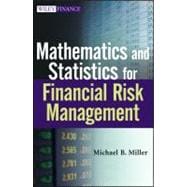
Michael B. Miller studied economics at the American University of Paris and the University of Oxford before starting a career in finance. He has worked in risk management for more than ten years, most recently as the chief risk officer for a hedge fund in New York City.
Acknowledgments xi
CHAPTER 1 Some Basic Math 1
Logarithms 1
Log Returns 3
Compounding 4
Limited Liability 5
Graphing Log Returns 5
Continuously Compounded Returns 7
Combinatorics 9
Discount Factors 10
Geometric Series 11
Problems 16
CHAPTER 2 Probabilities 19
Discrete Random Variables 19
Continuous Random Variables 20
Mutually Exclusive Events 26
Independent Events 27
Probability Matrices 28
Conditional Probability 30
Bayes’ Theorem 31
Problems 36
CHAPTER 3 Basic Statistics 39
Averages 39
Expectations 46
Variance and Standard Deviation 51
Standardized Variables 54
Covariance 54
Correlation 56
Application: Portfolio Variance and Hedging 57
Moments 60
Skewness 60
Kurtosis 64
Coskewness and Cokurtosis 67
Best Linear Unbiased Estimator (BLUE) 71
Problems 72
CHAPTER 4 Distributions 75
Parametric Distributions 75
Uniform Distribution 75
Bernoulli Distribution 78
Binomial Distribution 79
Poisson Distribution 83
Normal Distribution 84
Lognormal Distribution 88
Central Limit Theorem 90
Application: Monte Carlo Simulations Part I: Creating Normal Random Variables 92
Chi-Squared Distribution 94
Student’s t Distribution 95
F-Distribution 97
Mixture Distributions 99
Problems 102
CHAPTER 5 Hypothesis Testing & Confidence Intervals 105
The Sample Mean Revisited 105
Sample Variance Revisited 107
Confidence Intervals 108
Hypothesis Testing 109
Chebyshev’s Inequality 113
Application: VaR 114
Problems 124
CHAPTER 6 Matrix Algebra 127
Matrix Notation 127
Matrix Operations 129
Application: Transition Matrices 136
Application: Monte Carlo Simulations Part II: Cholesky Decomposition 138
Problems 141
CHAPTER 7 Vector Spaces 143
Vectors Revisited 143
Orthogonality 146
Rotation 152
Principal Component Analysis 157
Application: The Dynamic Term Structure of Interest Rates 162
Application: The Structure of Global Equity Markets 167
Problems 171
CHAPTER 8 Linear Regression Analysis 173
Linear Regression (One Regressor) 173
Linear Regression (Multivariate) 183
Application: Factor Analysis 188
Application: Stress Testing 192
Problems 194
CHAPTER 9 Time Series Models 197
Random Walks 197
Drift-Diffusion 199
Autoregression 200
Variance and Autocorrelation 205
Stationarity 206
Moving Average 212
Continuous Models 212
Application: GARCH 215
Application: Jump-Diffusion 217
Application: Interest Rate Models 218
Problems 220
CHAPTER 10 Decay Factors 223
Mean 223
Variance 230
Weighted Least Squares 231
Other Possibilities 232
Application: Hybrid VaR 233
Problems 234
APPENDIX A Binary Numbers 237
APPENDIX B Taylor Expansions 239
APPENDIX C Vector Spaces 241
APPENDIX D Greek Alphabet 242
APPENDIX E Common Abbreviations 243
Answers 245
References 283
About the Author 285
Index 287
The New copy of this book will include any supplemental materials advertised. Please check the title of the book to determine if it should include any access cards, study guides, lab manuals, CDs, etc.
The Used, Rental and eBook copies of this book are not guaranteed to include any supplemental materials. Typically, only the book itself is included. This is true even if the title states it includes any access cards, study guides, lab manuals, CDs, etc.